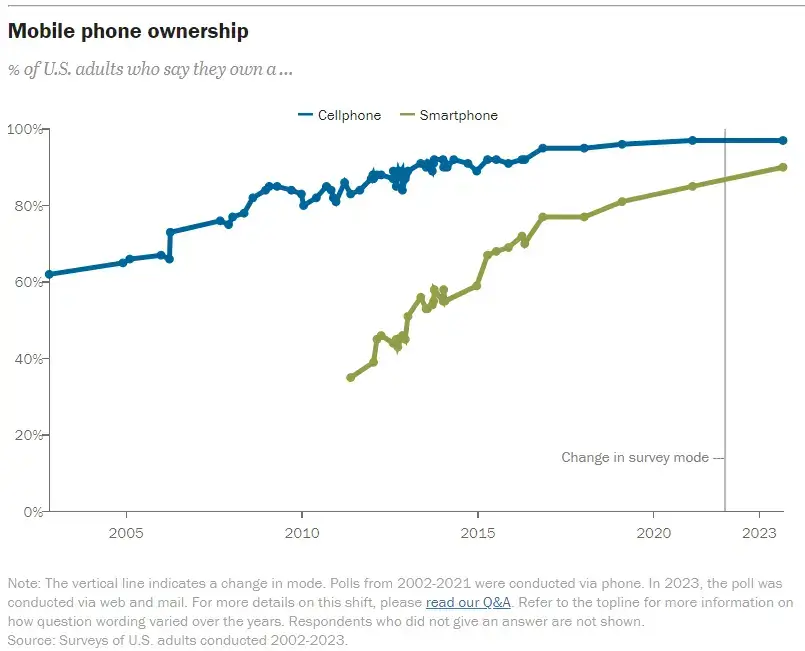11 Apr 2024
Dhaval Gajjar

11 Apr 2024
Dhaval Gajjar
Short message service (SMS), more commonly known as texting, remains one of the most used modes of communication globally. In 2023, 97% of Americans owned cell phones in general, while 90% owned a smartphone, according to 2024 data from the Pew Research Center. With 7% more owning a cell phone that is not a smartphone, you may more likely be able to connect with diverse groups through SMS or text marketing than other channels like social media or email marketing.
 (Image source: Pew Research Center)
(Image source: Pew Research Center)
Considering this, your business can benefit from including SMS in your marketing strategies to expand your audience reach. However, with the opportunity to easily connect with current and prospective customers comes the challenge of making common SMS marketing mistakes. Fortunately, you can avoid them by exploring each mistake and how to fix them.
Sending the same message to all of your leads and customers can result in lower relevance and engagement. If your audience cannot relate to your messaging, they may not care to read beyond the first sentence.
The Fix: Segment your audience. Audience segmentation is a marketing tactic that focuses on determining subgroups in your target market to provide them with more personalized marketing content and establish deeper customer relationships. You can subdivide your audience based on several characteristics:
Geographic location: This can be one’s country, region, city, or even neighborhood.
Age: This can be according to age brackets or chronological age ranges, such as teenagers, young adults, middle-aged, or elderly.
Ethnicity: This refers to shared cultural, racial, and national backgrounds, such as Hispanic, Asian, African American, etc.
Gender identity: You can segment your audience based on their self-identified gender. This can include categories like male, female, non-binary, transgender, etc.
Income: Try to classify your audience according to financial status or earning level.
Values: This can refer to your audience’s shared beliefs, principles, or ideologies.
Attitudes: This focuses on your audience’s opinions, behaviors, or perceptions toward specific topics, products, or services.
While a single message for your entire customer base might prevent you from spending more resources, you could miss out on authentically connecting with your customers based on their preferences and circumstances. You can conduct market research to understand your audience segments better, making it easier to tailor your content to meet their needs. Once you figure out your segments, you can automate bulk text messaging based on your audience subgroups.
Many businesses can be oblivious of what to do with their myriad of data. Understandably, working with large amounts of information can get overwhelming. This is why some businesses with decent offerings skip data analytics and go in blind when running their marketing campaigns.
The Fix: Invest in a team and tools. Even if it is only a team of one, a skilled data analyst with quality tools can go a long way. Data analytics can help you with virtually any project from start to finish. For instance, you can segment your audience using predictive analytics to identify consumer behavior and preferences.
Marketers may fail to test messages for different reasons, such as deadlines, limited resources, lack of awareness, fear of failure, and overconfidence. But testing messages gives you insights into their effectiveness. You will know the content and format that resonates best with your audience. Without testing, you cannot improve your content, timing, and format, affecting your engagement, conversion, and entire campaign.
The Fix: Use the A/B test. Also known as split testing, the A/B test in SMS marketing involves comparing the performance between two versions of a marketing message. For example, you randomly send two variations of a message with different calls to action (CTA) to different segments of your target audience. Even with simple data analytics, assessing the results can inform you about the better CTA choice and help you create more personalized SMS marketing campaigns for increased engagement.
What makes a good marketing message mainly depends on the content, the format, and the platforms that you use. While you must keep your marketing content consistent across all distribution channels, you still need to take the type of platform into consideration. This means eliminating the use of the same written materials verbatim for SMS, email, social media, and other channels and then reappropriating them based on the specific platform.
The Fix: Format your messaging for mobile. Mobile optimization ensures that content and platforms are designed for the best user experience on mobile devices. For SMS marketing content, this involves formatting your messages in a way that is concise, easily readable, and actionable. The following are qualities of content that is optimized for cell phones:
Written in 160 characters or less: To avoid split messages
Clear and direct messaging: To make it easy to read and understand on mobile devices
Actionable CTAs: To encourage your audience to respond
Optimal delivery times: To maximize engagement
Shortened URLs: To make your content easier on the eyes and your links easier to click
Some businesses are set in their ways. After all, why fix what isn’t broken? So, more often than not, they assume that they already know how to talk to their customers and that their campaigns are effective. However, when you disregard customer feedback, you lose the opportunity to understand them firsthand. As a result, you might not meet their preferences and needs.
The Fix: Listen to your customers. Read both the positive and negative comments that your customers leave. This allows you to understand the things you are doing right and the areas you need to improve on. You can also actively ask for customer feedback by including survey links, reply options, and open-ended questions in your SMS marketing messages. By taking in feedback, you might strengthen customer trust and brand reputation. Customer feedback may also help you measure the success of your SMS marketing campaign.
Flooding your subscribers with marketing messages can annoy and tire them, leading to increased opt-out rates and reduced engagement. Overly frequent sending SMS messages might also lessen the effectiveness of your campaign. Important details might get overlooked or ignored, and customers might perceive your brand as spammy or intrusive. This can negatively affect your reputation, customer relationships, and brand trust.
The Fix: Pace your messages with the help of previously mentioned fixes. Along with current marketing knowledge and experience, use data analytics and customer feedback to be informed about the best times and volume of SMS messages to send as part of your campaigns. Finding balance in this area helps keep customer interest and satisfaction as well as the impact of your marketing efforts.
Keeping up with each phase of marketing campaigns can be difficult. This includes the engagements and interactions with customers that come after publishing or sending out your marketing content. Failing to respond promptly to subscriber inquiries or concerns could result in missed opportunities and customer dissatisfaction.
The Fix: Set automated and manual systems. Just like how your team can benefit from staff scheduling software for punctuality and shift coverage, you can also take advantage of digital solutions for interactions between your employees and your customers. These include automated responses, customer service software, and the time-tested clear communication of response-time standards between you and your team.
In conclusion, SMS is a powerful tool for connecting with customers, considering the massive 2 trillion SMS messages sent in the United States (US) alone in 2021. However, you must navigate the SMS marketing space with care to avoid common pitfalls, such as overlooking segmentation and neglecting feedback to bombarding customers with messages and giving delayed responses.
Personalization, compliance, and timeliness are vital to avoiding common SMS marketing mistakes and maximizing the effectiveness of your campaigns. By tapping into the full potential of this digital channel, you can nurture customer relationships, drive conversions, and achieve all of your marketing objectives. Run your next impactful SMS marketing campaign with Textdrip’s free trial, or book a live demo to get started today!